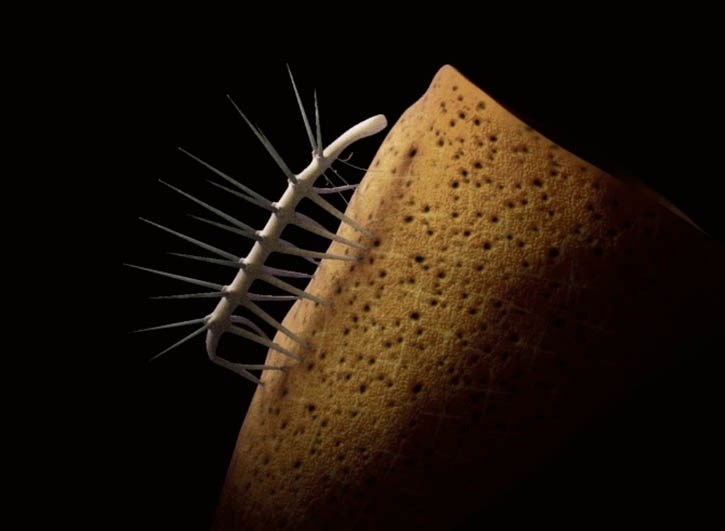Burgess Shale researchers have unlocked an ancient mystery behind the life of one of the 505-million-year-old fossil bed’s nightmarish worms.
Hallucigenia Sparsa, named after its dream-like appearance and distinguishable by the massive spikes on the back of its writhing body, has long been the subject of debate. Researchers had no idea where it lived, or if it had any relatives – until now.
Lead researcher Jean Bernard Caron, curator of Invertebrate Paleontology at the Royal Ontario Museum (ROM) published a paper Thursday (July 31) in the journal Proceedings of the Royal Society B stating that in fact Hallucigenia had relatives all over the globe during the middle Cambrian period, and is related to modern day velvet worms – a woodland creature that shoots streams of slime at its prey.
“Now, with more research in the Burgess Shale and China and other sites where similar forms have been found, we can conclude that this animal was found worldwide,” said Caron. “From Canada to the United States, China to Mongolia and the United Kingdom to Australia, we now know that during the Cambrian period Hallucigenia had relatives all over the world.”
Originally thought to be rare, Caron now believes these nightmarish spikey worms were common in the world’s oceans based on the spikes on its back.
While the Burgess Shale was the only spot where more complete fossils of Hallucigenia were found, their spines closely resembled another group of spiny micro-fossils found around the globe. Both Hallucigenia’s spines and the other spiny structures were formed in a similar fashion, resembling a stack of ice cream cones.
“The reason we were able to relate them convincingly, is the spines have little scales. It’s very distinct,” Caron said.
The Burgess Shale is unique, as it is one of the only spots on the planet where Cambrian fossils were well preserved.
Caron and his fellow researchers concluded that the similarities were close enough to determine they were related.
“The hard bits and pieces of animals found in conventional fossil deposits go hand in hand with the information provided by the Burgess Shale and similar exceptional deposits. Taken together, these data sources provide an unrivalled insight into the evolution and ecology of the earliest complex animals,” said Dr. Martin Smith from the University of Cambridge, co-author of the study.
Caron said the spines are usually defensive in nature, and theorizes Hallucigenia was likely a micro-predator or scavenger during the Cambrian age. It was only the size of a thumbnail, and the spikes would have been necessary now that it’s understood the Cambrian oceans had much larger predators than ever thought.
In a 2008 paper, Caron said Hallucigenia were rare, and only represented 0.19 per cent of all of the specimens counted in the Walcott Quarry in Yoho National Park.
“A lot of scientists are happy to see that. The other isolated spines were quite enigmatic. Anything that helps us understand the spines helps us understand the animal,” Caron said.
Finding modern day relatives was also tricky, as it appears as if Hallucigenia has no relatives living in the ocean. Its closest modern day relative – the velvet worm – can be found in jungles in Central and South America as well as parts of Australia. Both Hallucigenia and the velvet worm share a similar body design with unjointed apendages.
Caron said more research is ongoing on with Hallucigenia, as its head is still not well understood. For years, researchers were uncertain what part of it was right side up or down, and it wasn’t until the early ’90s that scientists figured out it had tentacle-like legs with claws, which were different than the spikes on its back.
This is Caron’s third important Burgess Shale discovery of 2013.
Parks Canada spokesman and former Burgess Shale interpreter Omar McDadi said the discovery is significant because it adds another layer of understanding to one of the Burgess Shale’s most famous charaters.
“The Burgess Shale is like a cool rock band, like the Beatles. In their time, they had a hit every week. The Burgess Shale is like that,” McDadi said. “Every living animal on the planet can be traced back to the Burgess Shale, and Hallucigenia is one of its most well known characters. The Burgess Shale is to biology lovers what Star Wars is to sci-fi fans, and (Hallucigenia) is like Han Solo.”
Hallucigenia fossils were originally discovered in the Burgess Shale in 1911 by Charles Walcott, and originally thought to be part of the annelid classification. He named it Canadia Sparsa. That interpretation was changed in 1977, when Conway Morris demonstrated it was another species altogether, and renamed it Hallucigenia, when it was thought to walk on its spikes. That changed again in 1991, when its tentacles were discovered.
The Burgess Shale Walcott Quarry is located above Emerald Lake in Yoho National Park. Visits to the site can be organized through Parks Canada and the Burgess Shale Geoscience foundation.




